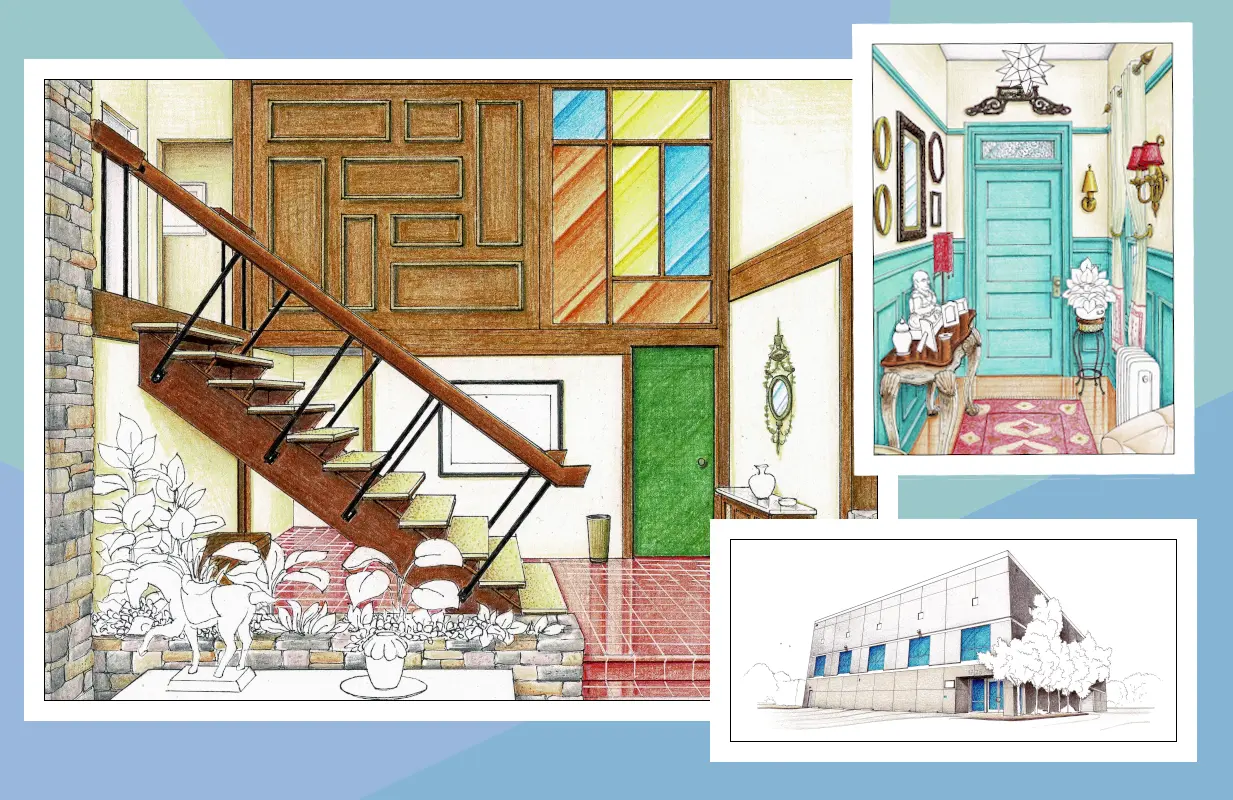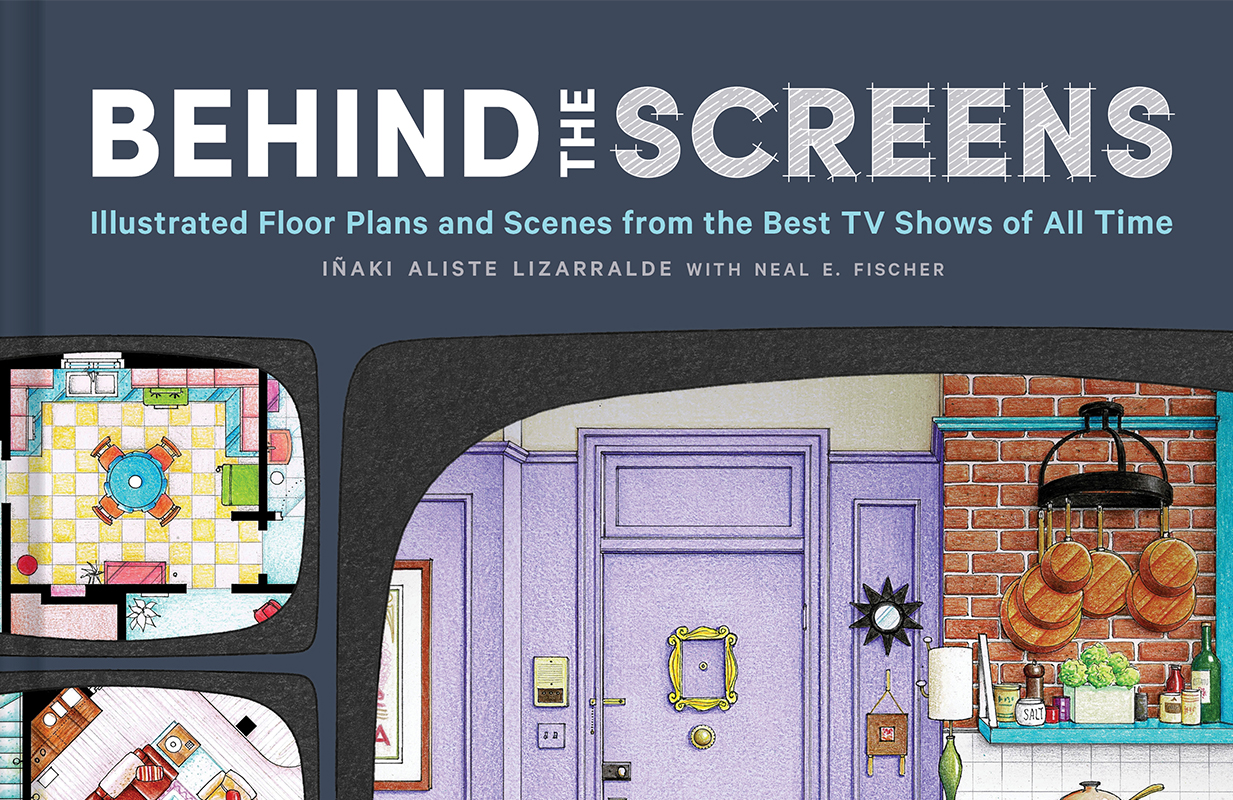Going Behind the Screens of TV's Most Iconic Homes and Offices
-
 Illustrations by Iñaki Aliste Lizarralde (Images courtesy of Chronicle Books; Primetimer graphic)
Illustrations by Iñaki Aliste Lizarralde (Images courtesy of Chronicle Books; Primetimer graphic)Say what you will about Dr. Frasier Crane, but his personal taste was nearly as discriminating as he proclaimed it to be. The downtown Seattle apartment where he lived during the run of Frasier was an envy-inducing thing of beauty with spectacular, if implausible, views of the city skyline.
Like a lot of Frasier fans Iñaki Aliste Lizarralde spent a lot of time admiring Elliott Bay Towers, Apartment 1901. But because he’s an interior designer and illustrator, his admiration took a practical turn: one day, just for fun, he drew up a floor plan of the entire apartment and shared it on social media.
A couple of years later, a friend asked him to do Monica’s apartment on Friends and Carrie Bradshaw’s on Sex and the City. And then he branched out into offices, hangouts, and entire TV towns, often based on suggestions from his Instagram followers. Now his drawings have been collected in a new book called Behind the Screens: Illustrated Floor Plans and Scenes from the Best TV Shows of All Time. It contains drawings from 35 TV shows ranging from I Love Lucy to Schitt’s Creek, plus commentary and trivia by writer and Triviality podcast host Neal E. Fischer.
Lizarralde lives in Spain and says he’s only an obsessive TV watcher when he’s working on a floor plan. His main criterion for deciding what to draw is whether he finds a space interesting. The Sterling Cooper offices and the Draper family home in Ossining in the early seasons of Mad Men, for example, was too conventional for his taste. He found Don Draper’s Manhattan penthouse and the SCDP offices in the Time Life Building, both epitomes of mid-century modern design, much more exciting. As a bonus, the series showed much more of the later office, including bathrooms, the reception area, and individual partner spaces, which gave Lizarralde much more to work with.

He begins each drawing by downloading the entire series and scouring the Internet for screen captures and other information about the sets. He takes reference photos so he can calculate the measurements of walls, windows, and furniture before drawing them to scale. “It’s something very similar to making a puzzle since there are usually undefined spaces that must be located and interconnected,” he explains in an emailed interview.In some cases, he takes some artistic license to fit the pieces together, imagining spaces like bathrooms and external hallways that never actually appeared onscreen.
The most challenging part of making each drawing is transforming a TV set into a structure that could actually exist in the real world. Set designers don’t think like architects: they only build what they need to film, and the rooms have to be large enough to accommodate lights and camera movements. (This is why the How I Met Your Mother gang always sat in the same booth at MacLaren’s: it was too much trouble to move them around.) Entire walls are missing. Hallways lead nowhere. Rooms appear and disappear during the run of a show. The problem is compounded in houses. It’s rare, Lizarralde says, to find a show where the upper and lower floors fit together.
Some shows are more aware of these discrepancies than others. Lizarralde includes drawings of how the exteriors of the Brady Bunch and Gilmore Girls houses would have looked if they actually matched what was shown on TV; the results would have probably made Mike Brady lose his architecture license. An animated show like The Simpsons can acknowledge the absurdity. “In one episode,” Lizarralde says, “[the creators] made Marge Simpson say: ‘Well, there's a rec room off the kitchen. But sometimes it's there and sometimes it isn't. Our house is very odd that way.’” (In Lizarralde’s floor plan, it’s there.)
Because Behind the Screens is a book about interior design and not real estate, Lizarralde and Fisher don’t waste any time discussing the plausibility of whether a character could actually afford their house or apartment. (In some cases, the discussion is futile anyway, as in The Good Place, which is set in the afterlife.) “Why take the fun out of the show?” Fischer asks.

Lizarralde has a more complex theory: “When the series is a drama, more realistic, or more serious,” he says, “the sets are also usually more realistic.” Friends is a comedy, not a documentary, so it’s able to present a fantasy world where chefs and baristas and struggling actors and musicians can afford palatial apartments in the West Village. In the drama Broadchurch, however, Detective Inspector Alec Hardy lives in a modest bungalow, not a sprawling cliffside home.
Of all the fictional homes in the book, Lizarralde’s favorite remains Frasier’s Seattle apartment. But he wouldn’t want to live there. Instead, he’d prefer to live in the country or a small town, in a cottage like Eleanor Shellstrop’s in The Good Place.
However, he’s looking forward to seeing Frasier’s new Boston digs in the Frasier reboot. “From the first images of the set,” he says, “it seems that he keeps his good (and expensive) taste in the selection of furniture and decoration…. The first reboot season is quite short, but if the series continues for more seasons, we will be able to see more of it, what is upstairs, and, with enough information, I could make a floorplan of the new space!”
Aimee Levitt is a writer and editor based in Chicago.
TOPICS: Frasier, The Brady Bunch, Friends, I Love Lucy, Mad Men, The Office (US), Schitt's Creek, Seinfeld, Sex and the City, The Simpsons, Behind the Screens: Illustrated Floor Plans and Scenes From the Best TV Shows of All Time, Books, Set Design
- The End of Friends and Frasier Changed the Communal Viewing Experience Forever
- Frasier Co-Creator on Season 1 Finale and Why Some Viewers 'Refuse to Enjoy the Show'
- Lilith Will Dunk on Frasier From Any Show and Any Timeline, Thank You Very Much
- Are You Listening? Because We Have Some Questions about Frasier's Chicago Talk Show